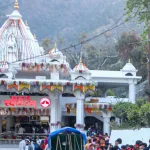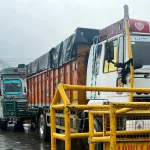UTTARKASHI DISASTER
There was a time when the word “cloudburst” conjured images of distant Himalayan heights—those inaccessible ridges where the clouds gathered in isolation and occasionally wept with such intensity that torrents would come crashing down into the deep gorges. It was an event the villagers heard of, not one they feared personally. But now, the clouds are no longer breaking only on remote summits—they are collapsing over rooftops, market lanes, and village paths. The sky is falling lower. The threat has descended.
The tragedy that unfolded in Dharali, a quiet hamlet in Uttarkashi, was a horrifying manifestation of this change. In mere minutes, a cloudburst transformed serenity into sorrow. A whole village—its houses, shops, roads, and lives—was swept away by an unrelenting wall of water and debris. It wasn’t just a flash flood. It was annihilation. People had no time to run, no warning to react. What descended from the sky was not rain, but ruin.
This is not the first time nature has cried out in this region, but something fundamental has shifted in the pattern. Once confined to higher altitudes, cloudbursts are now striking at lower elevations—where people live, work, and dream. It is not just geography that is changing, but the nature of risk itself. Places once considered safe are now marked red. Mountains that once nurtured now threaten. And all of this is happening with a regularity that is alarming.
Dharali had no large river snaking through its heart. There was no looming glacier threatening to give way. It was a modest, peaceful village. But when the sky itself becomes the source of destruction, there is no terrain that remains immune. This wasn’t merely a case of excessive rainfall—it was an atmospheric fracture. A collapse of equilibrium. And in its wake, silence.
In the last three years alone, Himalayan states like Himachal Pradesh and Uttarakhand have suffered repeated shocks. In 2023, it was Kinnaur. Then came Chamba. And now, Dharali. Each time, the scale has grown. Each time, the distance between tragedy and population has shrunk. What used to be a phenomenon of the upper wilderness is now a deadly visitation in our own courtyards. It is no longer nature’s distant fury—it is a scream in our ears.
These catastrophes are not isolated acts of chance. They are the echoes of years of environmental imbalance. The mountains, once considered sacred and inviolable, are now being carved, dynamited, and tamed in the name of development. Concrete roads cut through ancient forests. Hydropower projects twist the arteries of rivers. Forests that held soil and memory together are vanishing. And in this dizzying pursuit of progress, we have forgotten that the Himalayas are not just rocks—they are living, breathing ecosystems.
When such ecological wounds go unhealed, nature responds. Sometimes in landslides. Sometimes in floods. And increasingly, in cloudbursts. This is no longer an occasional anomaly—it is a pattern. One born of altered rainfall systems, rising temperatures, disappearing tree cover, and a loss of balance between what we build and what we destroy. The clouds are not just full of water now; they are heavy with consequence.
In Dharali, the people who paid the price were not those who laid highways or sanctioned dams. It was the ordinary villager—the shopkeeper, the farmer, the child on his way to school. Their lives, their memories, their futures—all dissolved in a single unrelenting burst from the sky. And as always, it is those least responsible for climate collapse who suffer the most from its consequences.
What is most chilling is the speed. Cloudbursts give no space for retreat. The time between detection and disaster is so narrow that even the best of technology often fails to warn in time. What, then, is to be done? What hope is there when water falls not gently but violently, like judgment from above?
There are lessons here—but only if we are willing to draw them with honesty. We must acknowledge that the development model we have pursued in the Himalayas is flawed—recklessly ambitious, and deeply disconnected from ecological realities. The hills are not places to be conquered, but to be coexisted with. Every tunnel bored, every forest cleared, every stream diverted—these are not acts without consequence. The mountains remember. And when they respond, they do so with devastating force.
Preparedness must now become more than a bureaucratic term. It must be embedded in the fabric of planning, in the architecture of villages, in the daily consciousness of those who govern. Local communities must be trained, informed, and empowered. Infrastructure must be reimagined—not as dominion over nature, but as harmony with it. And above all, the voices of those who live closest to the land must be heard first and loudest.
Perhaps the deepest change we need is not infrastructural, but spiritual. Once, our ancestors treated mountains, rivers, and forests as sacred entities—not resources. Somewhere along the way, that reverence gave way to arrogance. We began to see nature not as a giver, but as a challenge to be overcome. Now, as the clouds burst over our heads, we are reminded that nature was never silent. She was patient. And now her patience is wearing thin.
Dharali is gone. But its memory must remain—not as another entry in a list of disasters, but as a turning point. A moment when we could no longer deny that the sky is falling lower. That the boundaries between nature and human life have blurred. That unless we stop treating the Himalayas as terrain to be conquered, we will find ourselves buried beneath their rage.
Cloudbursts are no longer distant phenomena. They are knocking at the doors of our homes. The question is—will we listen now, before the next one knocks them down?
(Author is RK Columnist and can be reached at: [email protected])








